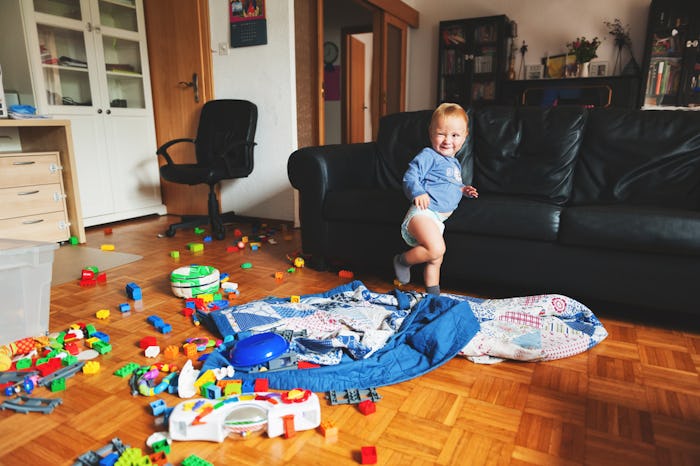Life

6 Hacks To Organize Toys To Keep Your Home From Looking Like A Daycare
Having kids means having kid stuff. Having kid stuff, for many of us, means having that kid stuff scattered all over the place, which, in turn, means spending ridiculous amounts of time trying to keep our homes from looking like a daycare center. Not to bad-mouth daycares — or nurseries or pre-Ks or any child care facility — but they're meant to look completely kid-centric. Most moms would prefer that their home isn't completely taken up by toys, where she can freely step barefoot without fear of being impaled by a stray LEGO brick.
Happily, there are ways to keep the clutter under control, and there are any number of websites and Pinterest pages that deal with this very topic. The first step is to determine just how impeccable you want your home to look. If the answer is "spotlessly perfect," then have a good laugh, take a deep breath, and start again. This time, rephrase the question: What are you willing to settle for?
Within that stricture, decide whether you want all of your children's belongings to stay in their room, or whether you can live with a system that allows the kids to leave some of their toys and games in common areas like the living room or family room, so long as they're stored in a neat fashion.
Once you've got that question answered, then take a look at these storage and de-cluttering hacks and see which ones might work for you. Or maybe you can figure out some tricks of your own, in which case I am in awe of you and want to invite you over.
Make Storage Bins Your Best Friend
Whether you go with full-on furniture organizers (like this one from Ikea), or bins from the dollar store, having a specific place for each type of toy is the easiest way to get your kids' things in order. Clear bins help your kids find just what they need, and labeling them with words and/or pictures makes it a snap to put the toys back where they belong.
Repurpose Containers
Next time you go to the dollar store, look for storage and travel containers that can be used to stow smaller kids' items. The Shady Tree Diary blog suggests using a soap travel box ($4, Amazon) to hold anything from playing cards (a lifesaver for parents like me, who always seem to find stray Uno or Things cards under the couch) to crayons to small at supplies.
And those cardboard carry-out cup holders from Dunkin' or Starbucks? Place clean plastic cups inside the holders, and you have an instant storage spot for crayons and colored pencils.
Rethink Your Own Decor
While you're doing your reorganizing, take a look around your living space and see if you can do some downsizing of your own. As A Mother Far From Home pointed out, all those scented candles, cute figurines, and empty vases from previous Mother's Days serve no purpose except to tempt little fingers and gather dust; plus, they make the room look more cluttered. Using a less-is-more approach to your decorating will make the room look more appealing, with or without toys on the floor.
Invest In Shoe Holders
Those clear over-the-door shoe organizers can be used for more than just footwear. Use them to hold dolls or action figures (as suggested by Organize Your Stuff Now), art supplies, costume jewelry, hair accessories, or whatever else your kids might need to access in a hurry.
Stow Puzzles Painlessly
Puzzles are a wonderful thing. They improve hand-eye coordination and visual acuity. They are also ridiculously hard to store neatly, especially because someone always ends up stepping on and crushing a corner of the box. Solution: Store them in zippered pouches, such as canvas pencil holders, suggested HuffPost Canada.
Get The Kids Involved In Cleanup
When playtime is over, there's no reason why you have to shoulder all the pick-up duty. Getting your children used to cleaning up after themselves will give them a sense of responsibility and save you some legwork in the long run. In my own pre-K classroom, students learn to put away their own materials from day 1, and we label bins and shelves with pictures so the children know what belongs where. Even toddlers can pitch in to a lesser degree, if you prompt them where to put the toys. If the kids tend to bring their playthings from their bedrooms to the living space, have a couple of baskets set aside for them to place the toys when they're done, the better to carry everything back to their rooms. (Just make sure that they empty the baskets and put the toys into their proper places afterward.)